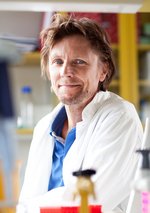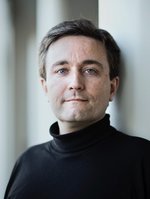
Carl Petersen studied physics as a bachelor student in Oxford (1989-1992). During his PhD studies under the supervision of Prof. Sir Michael Berridge in Cambridge (1992-1996), he investigated cellular and molecular mechanisms of calcium signalling. In his first postdoctoral period (1996-1998), he joined the laboratory of Prof. Roger Nicoll at the University of California San Francisco (UCSF) to investigate synaptic transmission and plasticity in the hippocampus. During a second postdoctoral period, in the laboratory of Prof. Bert Sakmann at the Max Planck Institute for Medical Research in Heidelberg (1999-2003), he began working on the primary somatosensory barrel cortex, investigating cortical circuits and sensory processing. Carl Petersen joined the Brain Mind Institute of the Faculty of Life Sciences at the Ecole Polytechnique Federale de Lausanne (EPFL) in 2003, setting up the Laboratory of Sensory Processing to investigate the functional operation of neural circuits in awake mice during quantified behavior.
His research aims to obtain a causal and mechanistic understanding of simple forms of sensory perception and associative learning at the level of individual neurons and their synaptic interactions within the complex neural circuits of the mammalian brain.

James L. McGaugh’s research focuses on the neurobiological systems that regulate the formation of lasting memories.
He is Research Professor of Neurobiology and Behavior at the University of California, Irvine, and he was the founding Chair of the department and founding Director of the Center for the Neurobiology of Learning and Memory. He is a member of the U.S. National Academy of Sciences and a Fellow of the American Academy of Arts and Sciences.
He received his Ph.D. from the University of California, Berkeley and did postdoctoral study with Nobel Laureate Daniel Bovet in Rome. He has received the William James Award from Association for Psychological Science, the Karl Lashley award from the American Philosophical Society, the John P. McGovern Award from the American Association for the Advancement of Science, the Distinguished Science Award from the American Psychological Association, the Laurea Honoris Causa from the University of L’Aquila in Italy, and the Grawemeyer Award.

In this talk I will present the work of the AU-based citizen science platform, www.scienceathome.org, which through online games enables ordinary citizens to assist in solving research challenges in fields like quantum physics, chemistry, engineering, psychology, economics, and cognitive science. The games have been played by more than 150,000 people and results from the flagship game, Quantum Moves, have demonstrated that players exhibit superior problem solving abilities compared to state of the art computer algorithms.
We believe that the mechanism behind the player success is the human ability to rapidly form an intuition for novel challenges and turn this into heuristic strategies. In an interdisciplinary team of physicists, social, cognitive, and computer scientists we study systematically these processes of strategy formation and look for correlations with personal cognitive and physiological traits.

In iPSYCH our overarching aim is to identify causes and disease mechanisms in mental disorders. We apply multi-facetted and integrative approaches to achieve this goal, including investigations of genetic and environmental factors in large population based cohorts as well as functional investigations of cellular and animal models. In my talk I will give a short overview of iPSYCH with a focus on genetics and present some of our recent results from ongoing genome-wide association studies and, if time permits, also from ongoing whole exome sequencing studies, both representing the largest studies in the field.
Learn more about iPSYCH: http://ipsych.au.dk/

Marco Capogna graduated in Experimental Psychology in Rome, Italy, and in Biology in Pisa, Italy. He received his PhD in Neuroscience at the Medical School of the University of Pisa. From 1991 to 1998, we worked with Prof Beat Gahwiler and Dr Scott M. Thompson at the Brain Research Institute of the University of Zurich, Switzerland. Subsequently, he moved to the UK as a Senior Scientist of the Neurophysiology Laboratory at the Novartis Institute for Medical Sciences, University College London. Marco’s research training also includes a stay at the Department of Clinical Neuropharmacology of the Max Planck Institute for Psychiatry, Munich, Germany. From 2001, Marco was a group leader at the MRC Anatomical Neuropharmacology Unit, University of Oxford. In 2016, Marco was recruited as Professor in Neuroscience to the Department of Biomedicine at Aarhus University, Denmark.
Marco’s past experimental work suggested novel mechanisms of the modulation of transmitter release, such as a direct interference with presynaptic exocytotic proteins, induced by the activation of presynaptic receptors or neurotoxins. Currently, Marco is interested in understanding cortical and subcortical circuits that guide emotional-dependent behaviours. To achieve this goal, he studies the physiological role of identified neuron types in the human cortex, and in the hippocampus and amygdala of rodents, with an emphasis on GABAergic neurons. Marco uses a wide range of techniques, including electrophysiology in vitro and in vivo, voltage-sensitive dye imaging, and high-resolution anatomy.

The Yonehara group investigates the structure, function and development of neural circuits in the visual system. The group is interested in the role of different cell types in neuronal circuits and the genetic, and molecular mechanisms of how those circuits are assembled during development. The methods used include two-photon imaging, electrophysiology, optogenetics, trans-synaptic virus, genetic labeling, molecular biology, genomics and behavioral analysis.
The research is based on the central hypothesis that functionally important neuronal circuit motifs are repeatedly used across various brain regions and species, and therefore identifying and understanding the structure and function of such motifs could give insights into the functional organisation of the brain. The mouse visual motion circuits, particularly the retina and its direct brain target the superior colliculus, provides us with an approachable substrate to work towards this goal, given its functionally and genetically well-defined cell types, multi-layered organization and tractable visually-guided behaviors. Two key organising principles that characterize not only the visual motion circuits of mammals and insects, but also other neuronal systems, are 1) parallel processing and 2) asymmetry of neuronal connectivity. The research group has focused, and will continue to focus, on questions relevant to these organising principles.

Lars Juhl Jensen started his research career in Søren Brunak’s group at the Technical University of Denmark (DTU), from where he in 2002 received the Ph.D. degree in bioinformatics for his work on non-homology based protein function prediction. During this time, he also developed methods for visualization of microbial genomes, pattern recognition in promoter regions, and microarray analysis. From 2003 to 2008, he was at the European Molecular Biology Laboratory (EMBL) where he worked on literature mining, integration of large-scale experimental datasets, and analysis of biological interaction networks. Since 2009, he has continued this line of research as a professor at the Novo Nordisk Foundation Center for Protein Research at the Panum Institute in Copenhagen and as a founder, owner and scientific advisor of Intomics A/S. He is a co-author of more than 150 scientific publications that have in total received more than 15,000 citations. He was awarded the Lundbeck Foundation Talent Prize in 2003, his work on cell-cycle research was named “Break-through of the Year” in 2006 by the magazine Ingeniøren, his work on text mining won the first prize in the “Elsevier Grand Challenge: Knowledge Enhancement in the Life Sciences” in 2009, and he was awarded the Lundbeck Foundation Prize for Young Scientists in 2010.
Methodological advances have in recent years given us unprecedented information on the molecular details of living cells. However, it remains a challenge to collect all the available data on individual genes and to integrate the highly heterogeneous evidence available with what is described in the scientific literature.
In my presentation he will describe the STRING database (http://string-db.org), which is widely used in the proteomics community. It aims to provide critical assessment and comprehensive integration of protein–protein interactions, including both direct physical interactions and indirect functional associations. The latest version of STRING covers more than 2000 organisms for which it includes evidence from a diverse range of curated databases, raw data repositories, automatic text mining of biomedical literature, and computational prediction methods.
He will also give a brief introduction and hands on demonstration of the Cytoscape network tool, focusing on how one can retrieve networks from STRING pertaining to topics of interest and subsequently analyze and visualize them.